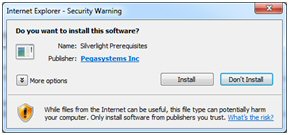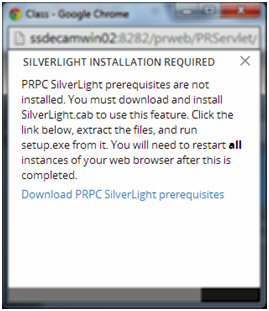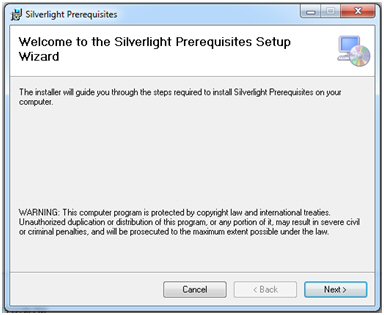Word merge support with Microsoft Silverlight plug-in
Valid from Pega Version 7.1.3
PRPC features that integrate with the Word merge capability are now cross-browser. ActiveX controls (which are only compatible with IE) have been replaced with Microsoft Silverlight. This plug-in must be downloaded separately from Microsoft, as it is not shipped with PRPC.
Some common PRPC features affected by this change include the Application Document Wizard, App Profile, Specifications Landing Page, Specification form, and Case Type Landing Page.
Prior to using these features, Users of PRPC 7.1.3 need to set up their client system(s) as follows:
1. Install Silverlight plug-in
Follow the PRPC prompt to install Silverlight when you attempt to use the Word merge feature:

Or download package directly: www.microsoft.com/silverlight/
2. Install PRPC prerequisites
Microsoft Internet Explorer (IE) browsers automatically detect the need for PRPC prerequisites and will prompt for install:

Non-IE browsers will load a pop-up window when the user attempts to use the Word merge feature. Use the link to manually download PRPC prerequisites:

Extract the .zip file, execute setup.exe and follow the install wizard:

Administrators setting up multiple clients at once may refer to the pzSLpreReqs.cab available in the PRPC 7.1.3 resource kit.
3. Restart browser
Log out of PRPC, close all open sessions and restart your browser.
The PRPC feature integrated with Word merge is now ready for use; Silverlight prompts are no longer displayed.
4. Troubleshooting
Silverlight installation requires access to your file system and a registry setting update to “trust” the associated Verisign certificate. Contact your administrator if you encounter any security or permission errors during this process.
See the PRPC Developer Help for more information on browser setup requirements.
Data Management
Valid from Pega Version 7.1.3
Improvements to data handling were made for the Data Pages, autopopulate properties, and reference properties. Lightweight lists were optimized.
- Property references are now maintained on the Work Page.
- PageList properties can reference a Data Page.
- Auto-populate properties can be used in a seciton to show results from a Data Page.
- Data Pages can run in “Page” mode as well as “List” mode
- The "Rules Not Using Lightweight List" report was enhanced.
- A PageList property that references a Data Page may be used to populate a grid.
- Related autopopulated properties can now be referenced.
Integration
Valid from Pega Version 7.1.3
Usability enhancements have been made to the integration wizards. The REST end-point integration has been improved, and XML parsing functionality has been enhanced.
- PRPC services can return Report or Listview data as XML.
- Work items may now be processed when accessing from a link in system-created emails.
- An SMTP outage will not cause an application to stop working.
- File listener will now read files using a leading asterisk (*).
- XML Parse rule will handle schema validation.
- PegaImageViewer will now work with Version 7.1.
- Security measures are enhanced for SOAP connections to web services.
- After generating rules using REST wizard, the Undo Generation button will delete all the generated rules.
- Email wizard has been improved.
Logging service now uses Apache Log4j 2
Valid from Pega Version 7.3
The Pega® Platform now uses the Apache Log4j 2 logging service. Apache Log4j 2 improves performance and provides support for all log file appender types. As a result of this upgrade, the prlogging.xml file has been renamed to prlog4j2.xml and the format of the file has changed considerably.
For details about the new file format see Pega Platform logging with the Log4j 2 logging service.
For new installations or for upgrades to systems that were using the default logging configuration, no changes are needed. For information about updating custom log files after upgrading, see Customizations to the prlogging.xml file must be manually ported after upgrade. For information about updating your socket server if you use remote logging, see Socket server has changed for remote logging. For information about updated the web.xml file after upgrading, see Log file description in web.xml incorrect after upgrade to Apache Log4j2.
Customizations to the prlogging.xml file must be manually ported after upgrade
Valid from Pega Version 7.3
As a result of the upgrade from the Apache Log4j 1 logging service to the Apache Log4j 2 logging service, the name of the logging configuration file has changed from prlogging.xml to prlog4j2.xml and the format of the file has changed considerably. If you customized your prlogging.xml file, port the customizations to the new prlog4j2.xml file. If you do not port the changes, the Pega® Platform uses the default prlog4j2.xml file and disregards your customized prlogging.xml file.
For more information about customizing your log files, see the Apache Log4j 2 documentation.
Socket server has changed for remote logging
Valid from Pega Version 7.3
As a result of the upgrade from the Apache Log4j 1 logging service to the Apache Log4j 2 logging service, the socket server that is used for remote logging has changed from the Log4j remote logging package with the LogFactor5 log analysis tool to TcpSocketServer. If you use remote logging, update your socket server to TcpSocketServer. For more information, see Installing and using remote logging.
Automatically process cases with SharePoint
Valid from Pega Version 7.3
You can now use Microsoft SharePoint Online to store and source case and Pulse attachments and to store and source attachments during automated case processing. Users only have to provide authentication and authorization details the first time they access SharePoint Online or when the trust has expired. The authentication profile must be OAuth 2.0 with a grant type of authorization code. The SharePoint Online component can be downloaded from Pega Exchange. For more information, see Downloading and configuring pluggable content management components.
Ability to set default values when importing data
Valid from Pega Version 7.3
You can now set default values for data that you import for a data type from a .csv file. By setting defaults, you can ensure that even when the .csv file data is incomplete, all of the data is imported. In addition, you can set default values for custom fields that do not have a matching source column in the .csv file. This feature is available for the Add and update and Add only import options. For mapped fields, the default value is used for new records if the source field is blank, and for existing records if both the source and target fields are blank. For custom fields, the default value is used for new records if a default value is provided, and for existing records only if the target field is blank.
For more information, see Importing data for a data type.
Ability to persist request data for synchronous REST Service failures
Valid from Pega Version 7.3
Request data can now be persisted when synchronous REST Service processing fails. To ensure that data is not lost and can be reprocessed, set the Execution Mode on the rule form to Execute synchronously (queue on error).
For more information see Service REST form - Completing the Service tab.
Create pluggable web storage components for case and Pulse attachments
Valid from Pega Version 7.3
You can now implement and post your own pluggable web storage components for use with case and Pulse attachments. These web components can be plugged in to Pega® Platform without the need to make changes to Pega Platform itself. The ability to create a pluggable web storage component is useful when you want to use a web storage provider that does not have an existing pluggable web storage component.
For more information, see Guidelines for creating pluggable components for storing and sourcing case and Pulse attachments.

